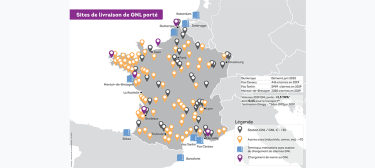The LNG small scale, a growing development at the service of energy transition
LNG is the cleanest of the fossil fuels. In the context of the current energy transition set by the European Commission, it represents an excellent alternative for reducing greenhouse gas emissions and combating global warming. This is why Elengy continues to develop its services and adapt its infrastructures to meet the ever-increasing demand for LNG, whether as fuel for maritime and heavy road transport or as an off-grid energy solution.
LNG small scale to reduce pollution
By replacing diesel, oil or coal, natural gas and LNG contribute to a significant reduction in environmental pollution: elimination of sulphur (SOx) and particle emissions, 80% reduction in nitrogen oxide (NOx) emissions and 20% elimination of carbon dioxide (CO2) emissions.
✔️A greener mobility for road transport,
✔️Reduction of the carbon footprint of manufacturers who have chosen to use gas instead of coal for their industrial processes.
This map illustrates the importance and diversity of the use of LNG carried, as well as the infrastructure that this implies.
It provides an overview to date on :
- the sites for delivery/consumption of carried LNG: both LNG filling stations and sites not connected to the grid,
- LNG ship loading points to highlight the bunkering service in France,
The data - the number of stations and sites, the number of tanks loaded at the terminals, the amount of LNG carried and consumed in France - shown in the 2 key data tables demonstrate the increasing use of LNG on a small scale, whether as a fuel for maritime and heavy road transport or as an off-grid energy solution.

Since the completion of this map, announcements of new stations have continued: the number of stations could double in the next 18 months.
